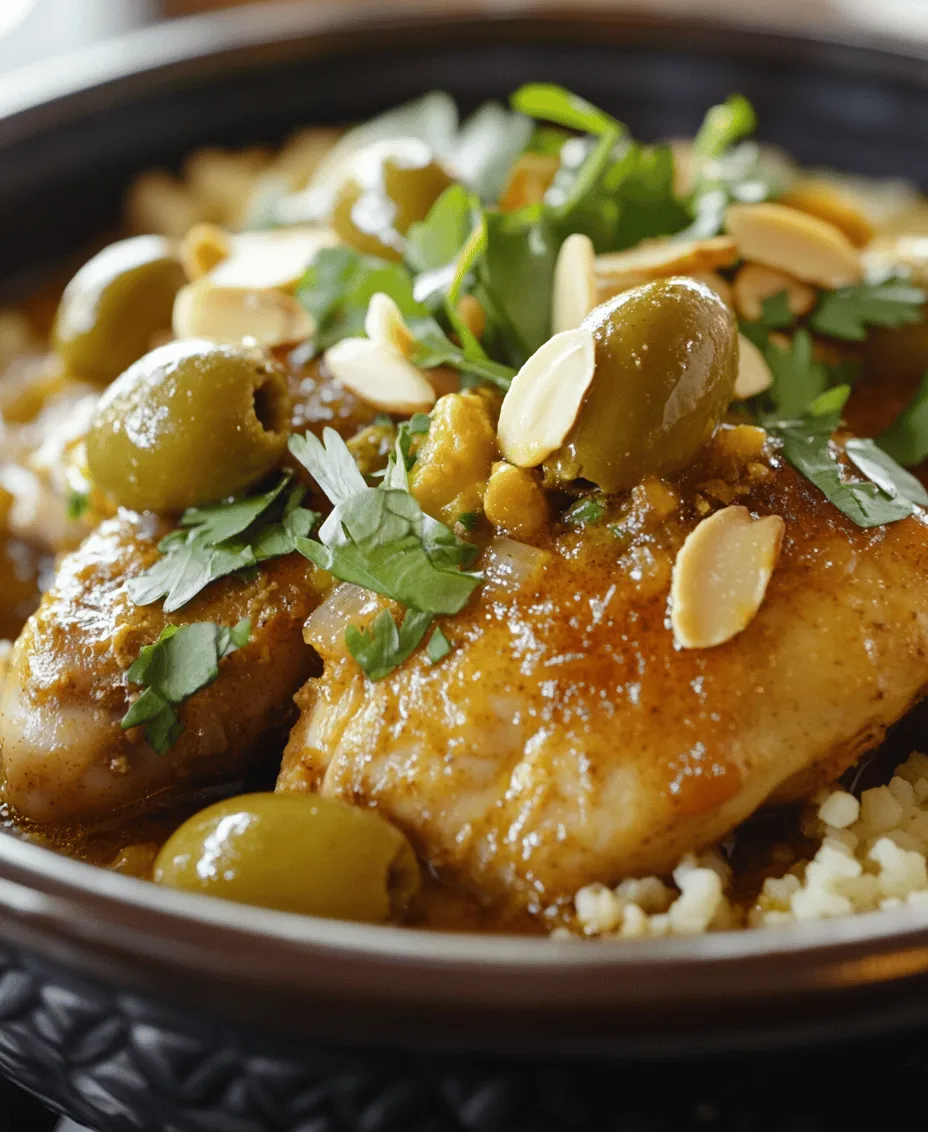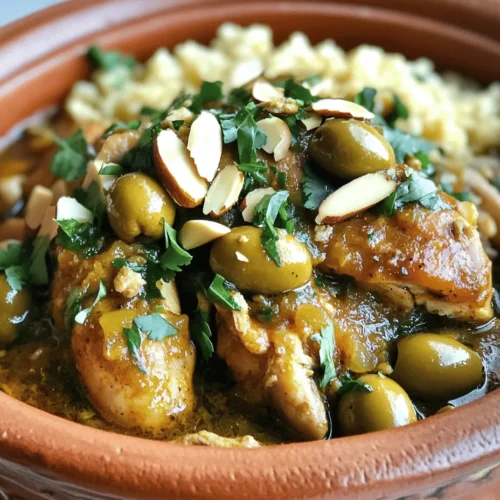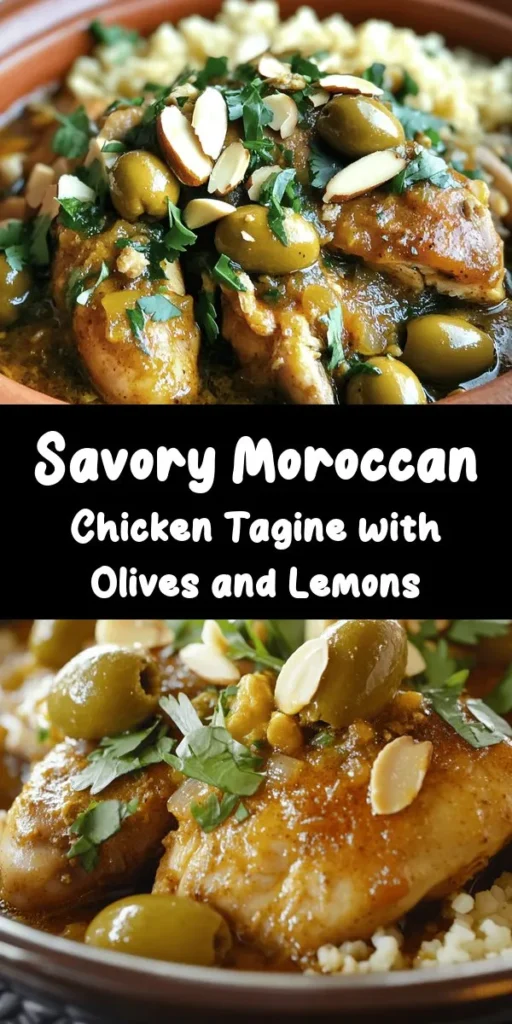Introduction to Moroccan Chicken Tagine
Delve into the rich and aromatic world of Moroccan cuisine with our delightful Moroccan Chicken Tagine with Olives and Lemons. This dish not only embodies the vibrant flavors of North Africa but also represents a culinary tradition that blends spices, textures, and colors in a unique way. The tagine—named after the traditional earthenware pot in which it is cooked—creates a tender, flavorful chicken dish that speaks of warmth and hospitality. It’s perfect for family gatherings or a cozy dinner at home, inviting you to share the experience with loved ones.
Moroccan Chicken Tagine is not just a meal; it’s an experience that transports you to the bustling markets of Marrakech, where spices fill the air and the vibrant colors of produce and textiles ignite the senses. As you savor each bite, you’ll find yourself immersed in the culinary heritage that has been passed down through generations. The combination of tender chicken, briny olives, and zesty lemons, all infused with a medley of spices, creates a symphony of flavors that is both comforting and exotic.
The Essence of Moroccan Cuisine
Understanding Moroccan cuisine is essential to appreciate the nuances of this dish. Its roots are deeply embedded in a history shaped by various cultures and influences over centuries. The Berbers, the indigenous people of North Africa, laid the foundation of Moroccan cooking with their use of local ingredients and traditional cooking methods. This was later enriched by Arab traders, who introduced spices and new cooking techniques, and Mediterranean influences that brought in fresh herbs and vegetables.
The result is a cuisine that celebrates diversity, where bold flavors and fragrant spices reign supreme. Moroccan cooking is characterized by its use of aromatic spices such as cumin, coriander, saffron, and cinnamon, frequently complemented by sweet elements like dried fruits and honey. The practice of slow-cooking in a tagine allows the ingredients to meld beautifully, creating dishes that are not only delicious but also visually stunning.
In Moroccan households, food is an expression of hospitality and generosity. Meals are often enjoyed communally, with family and friends gathering around a shared dish. The Moroccan Chicken Tagine with Olives and Lemons exemplifies this spirit, as it invites you to partake in a delightful culinary journey that brings people together.
Key Ingredients and Their Roles
The magic of Moroccan Chicken Tagine lies in its carefully selected ingredients. Each component plays a vital role in creating a dish that is rich in flavor and texture. Let’s explore the key ingredients that make this tagine truly special.
Chicken Thighs: The Heart of the Dish
When it comes to the protein in our tagine, bone-in, skin-on chicken thighs are the stars of the show. This cut of meat is known for its robust flavor and juiciness, making it ideal for slow cooking. As the chicken simmers in the tagine, the fat renders down, keeping the meat tender and moist while infusing it with the rich flavors of the spices and other ingredients. This is particularly important in Moroccan cooking, where the goal is to create harmonious flavors that meld together beautifully during the cooking process.
Using chicken thighs also allows for a more forgiving cooking experience. Unlike chicken breasts, which can dry out quickly, the thighs remain succulent and flavorful, ensuring that each bite is satisfying.
Spices: The Soul of Moroccan Flavor
The spices used in Moroccan cooking are what truly elevate the dish. Here are some key spices that contribute to the soul of our Moroccan Chicken Tagine:
– Ground Ginger: A warming spice that adds depth and a hint of sweetness. It is also known for its numerous health benefits, aiding digestion and providing anti-inflammatory properties.
– Ground Cumin: This spice offers an earthy, nutty flavor that enhances the overall richness of the dish. Its distinct aroma is a hallmark of Moroccan cuisine and pairs beautifully with the other spices.
– Turmeric: Not only does turmeric impart a vibrant golden color to the tagine, but it also brings anti-inflammatory properties to the table. Its warm flavor complements the other spices, creating a balanced profile.
– Ground Cinnamon: This spice introduces a sweet and spicy balance, enhancing the dish’s complexity. Cinnamon is often used in Moroccan cooking to add warmth and depth, making it a perfect addition to our tagine.
– Cayenne Pepper: For those who enjoy a bit of heat, cayenne pepper can be added to the mix. It provides an optional zing that elevates the dish, appealing to spice lovers while remaining adjustable to personal taste preferences.
Olives and Lemons: Brightness and Depth
Olives and lemons are quintessential elements of Moroccan cooking, and they play a crucial role in our tagine. The briny flavor of olives adds depth and a savory note that contrasts beautifully with the rich chicken. In Moroccan culture, olives are often served with meals, and their inclusion in this dish brings authenticity and a touch of tradition.
Lemons, on the other hand, contribute brightness and acidity that help to balance the richness of the chicken and the spices. Preserved lemons, commonly used in Moroccan dishes, bring a unique tartness that enhances the overall flavor profile. They offer a delightful contrast to the sweetness of honey, creating a well-rounded dish that tantalizes the taste buds.
Honey: Sweetness and Complexity
Honey plays a vital role in Moroccan Chicken Tagine, contributing a touch of sweetness that complements the acidity of the lemons. This balance is essential in Moroccan cooking, where contrasting flavors work together to create harmony. The sweetness of honey not only enhances the dish’s flavor but also adds complexity, making each bite more enjoyable.
In addition to its flavor, honey has health benefits, including antioxidant properties and natural energy-boosting qualities. Its presence in the tagine serves to elevate the dish while adhering to the principles of Moroccan cuisine, which often embraces the use of natural sweeteners.
Fresh Garnishes: Vibrancy and Texture
To finish off our Moroccan Chicken Tagine, we turn to fresh garnishes that add vibrancy and texture. Fresh cilantro is a common herb used in Moroccan cooking, bringing a burst of freshness and aroma that complements the spices beautifully. It also adds a pop of green color that enhances the visual appeal of the dish.
Slivered almonds are another fantastic garnish, offering a delightful crunch and nutty flavor that contrasts with the tender chicken and fluffy couscous or rice typically served alongside the tagine. Together, these garnishes not only elevate the dish’s presentation but also contribute to a more complex flavor profile, enriching the overall dining experience.
Step-by-Step Cooking Instructions
Now that we have explored the essence of Moroccan Chicken Tagine and its key ingredients, it’s time to dive into the step-by-step cooking instructions. This process will guide you through creating a dish that is both exquisite and satisfying.
Ingredients Needed
Before we begin, gather the following ingredients:
– 4 bone-in, skin-on chicken thighs
– 2 tablespoons olive oil
– 1 large onion, finely chopped
– 3 cloves garlic, minced
– 2 teaspoons ground ginger
– 2 teaspoons ground cumin
– 1 teaspoon turmeric
– 1 teaspoon ground cinnamon
– ½ teaspoon cayenne pepper (optional)
– 1 cup chicken broth
– 1 cup green olives, pitted and halved
– 1 preserved lemon, rind only, thinly sliced (or juice of 1 lemon)
– 2 tablespoons honey
– Salt and pepper, to taste
– Fresh cilantro, for garnish
– Slivered almonds, for garnish
Cooking Instructions
1. Prepare the Chicken: Start by patting the chicken thighs dry with paper towels. Season them generously with salt and pepper on both sides. This step is essential as it enhances the flavor of the chicken and helps achieve a golden-brown crust during cooking.
2. Sear the Chicken: In a large tagine or a heavy-bottomed pot, heat the olive oil over medium-high heat. Once hot, add the chicken thighs, skin side down. Sear them for about 5-7 minutes until the skin is golden and crispy. Flip the chicken and sear the other side for an additional 3-4 minutes. Once browned, remove the chicken from the pot and set it aside.
3. Sauté the Aromatics: In the same pot, reduce the heat to medium and add the chopped onion. Sauté for about 5 minutes until the onion becomes translucent and fragrant. Next, add the minced garlic and sauté for an additional minute, stirring frequently to avoid burning.
4. Add the Spices: Sprinkle in the ground ginger, cumin, turmeric, cinnamon, and cayenne pepper (if using). Stir the spices into the onion and garlic mixture, allowing them to toast for about 1-2 minutes. This step is crucial as it releases the essential oils in the spices, amplifying their flavors.
5. Deglaze the Pot: Pour in the chicken broth, scraping the bottom of the pot with a wooden spoon to release any flavorful bits stuck to the bottom. This adds depth to the sauce and enhances the overall taste of the tagine.
6. Return the Chicken: Return the seared chicken thighs to the pot, nestling them into the aromatic broth. Add the olives, preserved lemon, and honey. Ensure the chicken is well-coated in the mixture, and bring it to a gentle simmer.
7. Cover and Cook: Reduce the heat to low and cover the pot with a lid. Allow the tagine to simmer for about 45 minutes to 1 hour, or until the chicken is tender and fully cooked. The slow cooking process will allow the flavors to meld beautifully, creating a rich and fragrant dish.
8. Garnish and Serve: Once the chicken is cooked, taste the sauce and adjust the seasoning if necessary. Serve the Moroccan Chicken Tagine hot, garnished with fresh cilantro and slivered almonds. Pair it with fluffy couscous or warm crusty bread to soak up the delicious sauce.
With these steps, you are well on your way to creating a delectable Moroccan Chicken Tagine with Olives and Lemons that will impress your family and friends. The inviting aroma and vibrant flavors of this dish will transport you to the heart of Moroccan culinary traditions, making it a cherished addition to your recipe repertoire.

Preparing the Chicken
The first step in creating an authentic Moroccan Chicken Tagine is marinating the chicken. Marination is essential as it allows the spices to penetrate the meat, enhancing its flavor and tenderness. Begin by combining spices such as ground cumin, coriander, paprika, turmeric, cinnamon, and a pinch of cayenne pepper in a bowl, creating a fragrant spice blend that embodies the essence of Moroccan cuisine.
Once your spice mix is ready, rub it generously over the chicken pieces, ensuring that every nook and cranny is coated. This is where you can also add minced garlic and fresh ginger for an aromatic kick. After marinating, cover the chicken and let it rest for at least one hour. If time allows, refrigerating it overnight will yield even better results. This longer marination period allows the flavors to infuse deeply into the chicken, resulting in a more flavorful dish.
Sautéing Onions and Garlic
After marinating the chicken, it’s time to prepare the aromatic base that will elevate your dish. Heat a generous amount of olive oil in your tagine or a heavy-bottomed pot over medium heat. Add finely chopped onions and sauté them slowly. The goal is to achieve a perfect translucence, which can take about 10 minutes. Stir occasionally to prevent sticking and burning.
Once the onions are soft and translucent, add minced garlic and sauté for an additional minute until fragrant. The combination of sweet, caramelized onions and pungent garlic forms a robust foundation that will enhance the overall flavor profile of your tagine.
Browning the Chicken
Now, it’s time to brown the marinated chicken pieces. This step is crucial for building flavor; the Maillard reaction that occurs during browning adds depth to your dish. Increase the heat slightly and add the chicken pieces to the pot, skin-side down if using skin-on chicken. Let them sear without moving them for about 5-7 minutes until they develop a golden crust.
Avoid overcrowding the pot, as this can cause the chicken to steam instead of brown. You may need to work in batches if you are using a large amount of chicken. Once browned, flip the pieces and brown the other side. This process not only enhances the flavor but also locks in the juices, ensuring a succulent final dish.
Adding Lemons and Broth
Once the chicken is beautifully browned, it’s time to integrate the bright, zesty flavors of lemon. Add chopped preserved lemons (both the rind and pulp) to the pot, stirring them in to combine with the chicken and aromatics. The preserved lemons offer a unique tang that is characteristic of Moroccan cuisine.
Next, deglaze the pot by adding a splash of chicken broth or water. Scrape the bottom of the pot with a wooden spoon to lift any flavorful bits that have stuck, ensuring that nothing goes to waste. The liquid will help create a sauce that complements the chicken perfectly. Ideally, you want enough liquid in the pot to cover the bottom but not so much that the chicken is submerged. This balance will keep the chicken moist while allowing the flavors to concentrate.
Slow Cooking for Tenderness
Once you’ve added the broth and combined all the ingredients, it’s time for the slow cooking magic to begin. Reduce the heat to low and cover the tagine or pot with a lid. Allow it to simmer gently for about 1.5 to 2 hours. The low and slow cooking method allows the chicken to become tender and the flavors to meld beautifully.
During this time, check occasionally to ensure the sauce isn’t drying out. If needed, add more broth or water to keep the mixture moist. The goal is to have the chicken fall-off-the-bone tender while the sauce thickens to your desired consistency.
Final Adjustments to Flavor
With the slow cooking phase complete, it’s essential to taste and adjust the flavors before serving. Remove the pot from heat and stir in a handful of pitted green olives, allowing them to warm through in the residual heat. The olives add a briny contrast that beautifully balances the richness of the chicken.
At this point, consider if the sauce needs a touch more acidity. You can squeeze fresh lemon juice into the pot or add a little more of the preserved lemon if desired. Season with salt and pepper to taste, ensuring that every bite is perfectly balanced.
Serving Suggestions
When it comes to serving Moroccan Chicken Tagine, presentation is key. Traditionally, tagine is served directly from the pot, which adds to the communal dining experience. You can accompany the dish with fluffy couscous or crusty bread to soak up the flavorful sauce.
For an authentic Moroccan touch, consider garnishing with fresh cilantro or parsley before serving. This not only enhances the visual appeal but also adds a burst of freshness to the dish. Arrange the chicken pieces artfully on a large serving platter and drizzle some of the sauce over them, then scatter the olives and lemon pieces around for an inviting look.
Nutritional Benefits of Moroccan Chicken Tagine
Moroccan Chicken Tagine is not only a feast for the senses but also a nutritious meal option. Chicken is a great source of lean protein, essential for muscle repair and overall health. The addition of olives provides healthy fats, particularly monounsaturated fats, which can support heart health.
Lemons are rich in vitamin C, aiding in immune function and skin health, while the spices used in this dish—such as turmeric and cumin—are known for their antioxidant and anti-inflammatory properties. Together, these ingredients create a balanced dish that can fit well into a healthy diet, offering both nourishment and flavor.
Cultural Significance of Tagine Cooking
Tagine cooking is deeply rooted in Moroccan culture, symbolizing hospitality and communal dining. The tagine itself is a traditional earthenware pot that has been used for centuries, allowing for slow cooking and the development of rich flavors. In Moroccan households, meals are often shared among family and friends, emphasizing the importance of togetherness and celebration.
Cooking and sharing a tagine dish is more than just a meal; it’s an event that brings people together, fostering connection and conversation. This cultural practice highlights the significance of food in creating bonds and preserving heritage, making Moroccan Chicken Tagine not only a delicious dish but a meaningful culinary experience.
Conclusion: Bringing Moroccan Flavors to Your Table
Moroccan Chicken Tagine with Olives and Lemons is a culinary journey that encapsulates the vibrant flavors and rich traditions of Moroccan cuisine. This dish invites you to explore the exquisite combination of spices, the tangy notes of preserved lemons, and the savory depth of slow-cooked chicken.
By embracing this recipe, you are not only treating yourself to a delightful meal but also celebrating the communal spirit of Moroccan dining. So gather your loved ones, prepare this aromatic tagine, and let the flavors transport you to the bustling markets and warm kitchens of Morocco. Enjoy this cultural culinary adventure right in your own kitchen, creating memories that will linger long after the last bite.



